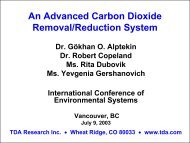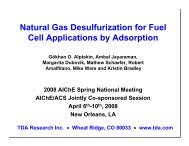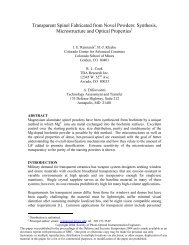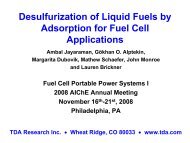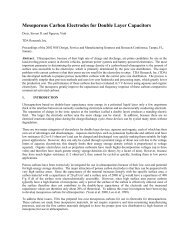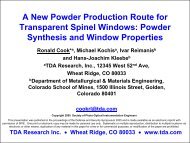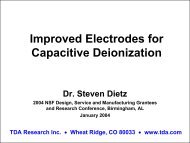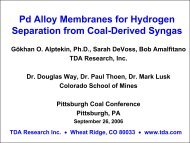Sorbents for Natural Gas Desulfurization - TDA Research, Inc.
Sorbents for Natural Gas Desulfurization - TDA Research, Inc.
Sorbents for Natural Gas Desulfurization - TDA Research, Inc.
You also want an ePaper? Increase the reach of your titles
YUMPU automatically turns print PDFs into web optimized ePapers that Google loves.
1210DMS Concentration (ppmv)864Norit RGM3,ActivatedCarbonGrace XZeoliteCe Zeolite -YCu Zeolite XSulfaTrap TM200 100 200 300 400 500 600 700 800 900 1000Time (min)Figure 1. Comparison of <strong>TDA</strong>’s SulfaTrap TM sorbent with other adsorbents. All sampleswere tested at 60,000 h -1 in a natural gas mixture containing 12.3 ppmv DMS, 8.9 ppmvTBM and 8.9 ppmv THT at T= 20 o C, P= 5 psig.Table 1. Pre-breakthrough capacities calculated <strong>for</strong> the samples shown in Figure 1.SamplePre-BreakthroughCapacity (% wt. S)<strong>TDA</strong>’s SulfaTrap TM Sorbent 3.12%Grace X Zeolite 0.36%Norit RGM3 Activated Carbon 0.18%The breakthrough profiles of all sulfur species <strong>for</strong> <strong>TDA</strong>’s SulfaTrap - R3 sorbentare presented in Figure 2. In agreement with the prior literature, DMS breakthroughoccurred first at 720 minutes, followed by the breakthrough of TBM at 1080 minutes.The breakthrough of THT was never observed during 1400 minutes of testing. Theseresults suggest that the affinity of the sorbent is weakest <strong>for</strong> the DMS and strongest <strong>for</strong>the THT. The saturation sulfur capacity of the sorbent was calculated as 3.88% wt. (thesaturation capacity is the total sulfur loading of the sorbent measured when the DMSconcentration at exit of the bed was equal to its inlet value).In addition to the small-scale tests, we also tested the per<strong>for</strong>mance of a few samplesin large-scale (engineering-scale tests that can be easy to scale-up). In these tests, weused 25 cc of sample and a calibrated gas mixture containing synthetic natural gas, with50 ppmv water and 50 ppmv DMS. The DMS breakthrough profiles are shown in Figure3 <strong>for</strong> two of the samples and the test results are reported in Table 2. The first test wasdone on activated carbon (Norit RGM3 Activated Carbon), which is the current industrystandard. The second test was done with our SulfaTrap sorbent. Our sorbent greatlyoutper<strong>for</strong>med the activated carbon, with 3.2% wt. breakthrough capacity. Note that thesulfur adsorption capacity measured in the large-scale tests and small-scale acceleratedtests were in good agreement (3.2% wt. capacity vs. 3.12% wt., <strong>for</strong> <strong>TDA</strong> SulfaTrap TM -R3,and 0.18% vs. 0.13% <strong>for</strong> Norit RGM3).3



